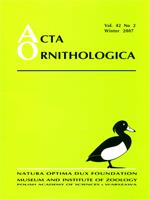In 1983–1999 in SW Poland (40 540 km2, 13% of the total area of Poland) the Rook was reported to nest in at least 270 colonies with a combined total of from ca. 18 to > 20 thousand breeding pairs. Between 1983–1988 and 1992–1999,105 (39% ) colonies were abandoned, i.e., 16–20% of the population as recorded in earlier periods. The largest drop in numbers (34%) occurred in rural populations. The median for abandoned colonies was 16 nests, which was nearly six times lower than that for active rookeries (median = 99). General linear models (GLM) indicate that the abandonment of colonies depends on their location (village, small town, city), the size and number of nests, and the presence of other rookeries in the vicinity of those studied. The best-fit model describing rookery extinction invoked the number of nests and other colonies within a radius of < 10 km from the colony studied. In each of three analyzed radii (10, 20 and 30 km) the numbers of nests and other colonies were decidedly higher around extinct rookeries. Active Rook colonies were farther away from the nearest rookery, and also from large colonies consisting of 50, 100 and 150 nests. The probability that a rookery would be abandoned was strongly negatively correlated with its size.
How to translate text using browser tools
1 December 2007
Different Extinction Risks of the Breeding Colonies of Rooks Corvus frugilegus in Rural and Urban Areas of SW Poland
Grzegorz Orłowski,
Andrzej CZapulak

Acta Ornithologica
Vol. 42 • No. 2
December 2007
Vol. 42 • No. 2
December 2007
concentric analysis
Corvus frugilegus
extinction risk
population decline
population distribution
Rook




